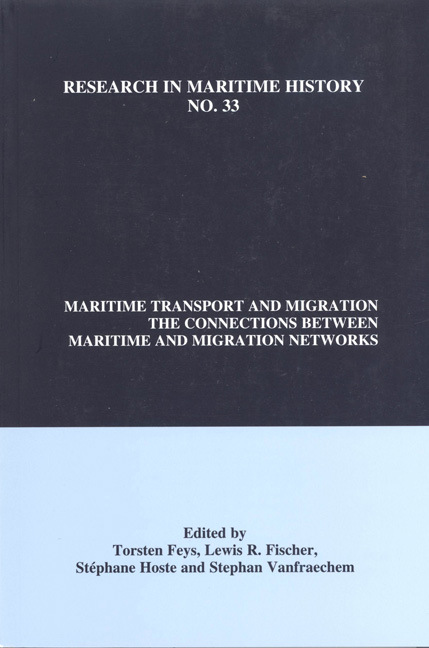Book contents
- Frontmatter
- Contents
- Contributors' Notes
- “Migration and Maritime Networks in the Atlantic Economy: An Introduction”
- “The First Waves of Internationalization: A Comparison of Early Modern North Sea and Nineteenth-Century Transatlantic Labour Migrations”
- “The Battle for the Migrants: The Evolution from Port to Company Competition, 1840-1914”
- “The Role of Foreign-bora Agents in the Development of Mass Migrant Travel through Britain, 1851-1924”
- “Transatlantic Emigration and Maritime Transport from Greece to the US, 1890-1912: A Major Area of European Steamship Company Competition for Migrant Traffic”
- “The ‘Relatives and Friends Effect:’ Migration Networks of Transatlantic Migrants from the Late Habsburg Monarchy”
- “Crossing the Last Frontier: Transatlantic Movements of Asian Maritime Workers, c. 1900-1945”
- “Costs, Risks and Migration Networks between Europe and the United States, 1900-1914”
- “Conclusion”
“The ‘Relatives and Friends Effect:’ Migration Networks of Transatlantic Migrants from the Late Habsburg Monarchy”
- Frontmatter
- Contents
- Contributors' Notes
- “Migration and Maritime Networks in the Atlantic Economy: An Introduction”
- “The First Waves of Internationalization: A Comparison of Early Modern North Sea and Nineteenth-Century Transatlantic Labour Migrations”
- “The Battle for the Migrants: The Evolution from Port to Company Competition, 1840-1914”
- “The Role of Foreign-bora Agents in the Development of Mass Migrant Travel through Britain, 1851-1924”
- “Transatlantic Emigration and Maritime Transport from Greece to the US, 1890-1912: A Major Area of European Steamship Company Competition for Migrant Traffic”
- “The ‘Relatives and Friends Effect:’ Migration Networks of Transatlantic Migrants from the Late Habsburg Monarchy”
- “Crossing the Last Frontier: Transatlantic Movements of Asian Maritime Workers, c. 1900-1945”
- “Costs, Risks and Migration Networks between Europe and the United States, 1900-1914”
- “Conclusion”
Summary
Transatlantic migration may begin from a desire for income gain, a strategy to avoid economic loss, a recruitment programme by employers, shipping lines or the state to satisfy demands for low-wage workers, or some combination thereof. Although wage differentials, relative risks, recruitment efforts and market penetration may continue to cause people to move, new conditions that arise in the course of migration come to function as independent causes. Migrant networks, for example, increase the likelihood for further migration because they lower the costs and risks and increase the expected net returns resulting from migration. These networks are a set of interpersonal ties that serve to connect migrants, former migrants and non-migrants in common origin and destination areas through ties of kinship, friendship and shared community origin. Once the number of migrants reaches a critical threshold, the expansion of networks causes the probability of migration to rise, which inspires further movement and expands the networks.
Within migration research the so-called “effect of relatives and friends” as support for information networks is widely argued. As Adam Walaszek stated, “[migration was typically organized by families, relatives, or friends. Recent migrants to America invited their relations and friends to follow in their shoes. Close ties existed between those who left for America and those who remained in European villages.” Although most migration historians emphasize the importance of these networks, there has been relatively little systematic analysis of the roles of family and kin in the process. While economists and sociologists have done some important studies on the impact of close and more expanded kinship groups, historical studies are close and more expanded kinship groups, historical studies are mosdy limited to the impact of the nuclear family.
The first attempt to analyze the relationships among migration and kinship groups was made in the context of movements to North America in the nineteenth century. This analysis was achieved through statistical sources. But such records are inadequate in addressing the question of whether the Atlantic was crossed mainly by individuals or family groups, since the identification of families is limited mostly to the family name and place of origin.
- Type
- Chapter
- Information
- Maritime Transport and MigrationThe Connections Between Maritime and Migration Networks, pp. 75 - 96Publisher: Liverpool University PressPrint publication year: 2007

